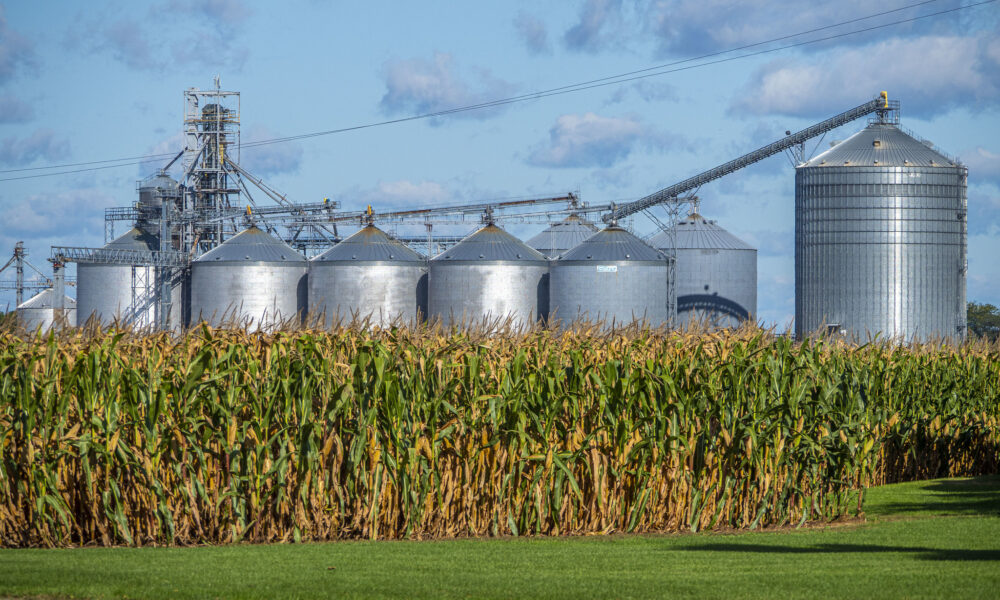The 2025 corn harvest is making headlines as the largest in US history. You’d think that would be good news. But instead of buoyed incomes, farmers face negative profits and taxpayers face billions in emergency federal outlays. The reason is simple: We’re planting more corn than the market can absorb, year after year.
Given current demand, I estimate corn producers could have broken even, instead of losing money as they are today, had they planted about 11 million fewer acres. The associated reduction in synthetic nitrogen fertilizer would have avoided a tremendous amount of nitrous oxide (N2O) emissions—17,000 metric tons of this lesser-known but powerful heat-trapping pollutant, or about what 1.1 million cars emit in a year. It also would have kept 170,000 metric tons of nitrate from making the water in many rural wells unsafe to drink.
High input costs and weak export markets—both distorted by tariffs—get the blame for the weak farm economy, but the bigger problem is structural. Back in the spring, when farmers put seed in the ground, they already knew they were headed for a big surplus.
Behind the headlines, two things are terribly wrong in farm country that most people don’t know about: First, farmers rarely make a profit on corn. Most years, their revenues don’t cover their production costs, and taxpayers make up the difference.
Second, most corn production exacts a heavy environmental toll. Many people know that the dominant production methods harm pollinators (like bees) and other beneficial organisms, contaminate drinking water, and make lakes, rivers, and downstream coastal waters hazardous. But corn also releases a staggering amount of N₂O, largely from synthetic nitrogen fertilizer applied to fields.
These are consequences of chronic overproduction. And agricultural economists point to one straightforward solution: plant less corn on fewer acres.
Every farm counts
We’ve already lost far too many farming families, and each one that disappears is a loss for rural communities and our food system. This year’s farm economy is pushing many growers to the brink, with mounting debt and collapsing prices threatening a wave of bankruptcies in the months ahead.
Policy should aim to keep every single farm family thriving—and grow their numbers. That means making farm economics work, not through endless subsidies or externalized environmental costs, but through a fair and functional market.
How does too much corn cause too little profit for farmers?
The answer is simple: supply and demand. Livestock, ethanol, and products like sweeteners and oils all require a large but relatively stable amount of corn. When farmers collectively plant more than that demand, oversupply drives down the price. (While not my focus here, the ethanol and livestock sectors also exhibit substantial market distortions and environmental costs.)
Based on recently released USDA numbers, I estimate that the large amount of surplus corn drove 2025 farm revenues down to about $159.50 per acre below the break-even point. In other words, corn prices would need to rise 22% just to cover farmers’ costs. (See my calculations below.)
This means production overshot demand by roughly 2.0 billion bushels—about the output of 11 million acres. Had those acres not been planted, prices would have been higher and average corn production revenues would have covered costs.
Surplus acres, surplus pollution
Planting less corn wouldn’t just mean fair pay for farmers and avoided taxpayer bailouts—it would also save billions in environmental damage.
Looking only at the pollution from synthetic nitrogen fertilizer use, I estimate that planting corn on those 11 million acres emitted about 17,000 metric tons of N₂O (4.7 MtCO₂e), moving us farther away from climate goals and likely causing around $940 million in damages. This is a conservative estimate; recent research suggests that soil microbes in US row crop fields convert synthetic nitrogen fertilizer into N₂O at a rate three times higher than standard factors suggest.
In terms of water pollution, this excess corn leached about 170,000 metric tons of nitrate into water supplies, making drinking water unsafe and harming aquatic ecosystems.
And remember: That’s the pollution just from the surplus acres of corn. It doesn’t count the damage from the other more than 80 million acres planted nationwide.
Why don’t farmers just plant less?
Partly because they can’t—because of something agricultural economists call “the treadmill of production.” Unlike Apple, which carefully forecasts demand and produces iPhones to match, farmers act individually. Suppliers and grain buyers—feedlots, ethanol refineries, exporters—are few and powerful, while farmers are many and disconnected. This imbalance means farmers can’t collectively reduce supply to stabilize prices.
Another reason is—you guessed it—subsidies. As I said above, farmers knew they were planting too much and wouldn’t break even again this year. Yet instead of being able to coordinate supply with demand—or having the government help them do so, as once was the case before agribusiness interests reshaped the system—today’s farm policy leaves them little choice but to plant as much as possible. Programs like crop insurance, price loss coverage, and marketing loans guarantee that taxpayers will shoulder the losses, creating incentives that perpetuate chronic overproduction of corn while disadvantaging alternative markets.
That’s why cooperatives and coordinated supply management matter (not that either is a silver bullet). As a member-owned cooperative, for example, Organic Valley has kept thousands of family dairy farms afloat by projecting demand and coordinating supply so that prices cover the true cost of production.
Smart farm policy has a role too, as it once did with the Agricultural Adjustment Act of 1933 (AAA). By paying farmers to cut acres, the AAA reduced oversupply, raised farm incomes, and provided critical relief during the depths of the Great Depression. Ironically, today’s farm bill—the AAA’s descendant—flips that logic. Instead of stabilizing markets, its subsidized crop insurance, direct payments, and other subsidies, together with ethanol mandates under the Renewable Fuel Standard, now fuel the very overproduction the law was meant to stop.
Of course, food is different from iPhones—because it nourishes people. But here’s the irony: Most US corn doesn’t actually feed people. About a third is burned as ethanol and much of the rest is fed to livestock and processed into sweeteners and oils. If Apple made iPhones the way we grow corn, it would be flooding stores with devices no one asked for, then selling them at a loss while taxpayers covered the difference.
This is the simple supply story. The real story is even more devastating. Once the United States locked itself into chronic corn surpluses, markets and policy evolved to soak up the excess. Ethanol emerged as a policy-enabled outlet and livestock systems intensified and consolidated to capitalize on low-cost feed. Advertising campaigns like “Beef. It’s What’s for Dinner” and “Got Milk?” are efforts to manufacture demand for mountains of surplus meat and dairy raised on unnaturally cheap grain.
A smarter path forward
The solution is as simple as it is difficult: stop overproducing. If we planted fewer acres of corn, farmers could earn a fair return without taxpayer bailouts, while pollution would drop dramatically. Real change will take time, but it starts with understanding the problem and uniting behind farmer-led solutions that restore both land and livelihoods.
Yes, feeding a growing global population is a real concern. But we’re far from that problem today. Right now, our crisis is overproduction—making society and the environment sick while driving skilled farmers out of business.
This isn’t radical. It’s how every healthy sector of the economy works. No car company produces unlimited vehicles just because it can. It projects demand, sets supply, and prices accordingly. Agriculture deserves the same rationality and fairness.
Because at the end of the day, every single farm matters. And if we want more farm families—not fewer—we need policy that makes that vision real.
Showing my work
Here’s the math for estimating oversupply and its consequences for farm income and the environment.
Step 1: Farmers’ bottom line. According to the USDA’s 2024 Costs and Returns data, it costs an average of $887.63 per acre to grow corn when you include full economic costs (not just out-of-pocket expenses). In 2024, average gross revenue was only $757.48 per acre, leaving farmers with a loss of ~$130 per acre. To estimate the net profit for 2025, we have to use the 2024 costs estimates until the USDA releases the new numbers in January. Costs are expected to rise (especially fertilizer) this year, so this will be a conservative estimate. On the revenue side, for 2025, the USDA’s September WASDE report projects yields of 186.7 bushels/acre at a price of $3.90/bushel, which equals ~$728 per acre. That’s a predicted shortfall in 2025 of ~$160 per acre.
Step 2: What price would farmers need? To break even, farmers would need that extra $160/acre in revenue. Spread across 186.7 bushels/acre, that means prices would have to rise by $0.85/bushel, or ~22% (from $3.90 to $4.75/bushel).
Step 3: How much would supply have to shrink? Prices rise when supply drops, but by how much depends on demand elasticity. For corn, -0.548 is a reasonable average based on published estimates (like this and this). (This means a 10% rise in price cuts demand by ~5.5%.) Using that elasticity, to get a 22% price increase, supply would need to shrink by roughly 12%. On a national corn crop of 16.8B bushels, that works out to about 2.0B bushels of excess supply, or the output of ~11M acres.
Step 4: N2O emissions from the excess corn. Corn farmers apply an average of 151.8 lb of synthetic nitrogen fertilizer per acre on the ~95% of corn acres that receive fertilizer. Multiply by 11M acres and that’s about 1.6B lb of nitrogen (N) applied to acres we didn’t need.
- Field emissions: In the United States, ~1.3% of synthetic N applied is released directly as nitrous oxide (N₂O-N), which equals ~20M lb N₂O-N. That 1.3% comes from higher rates in wetter fields (1.6% on ~74% of corn acres) and lower rates in drier fields (0.5% on ~26% of acres) but is often considered too low.
- Water emissions: The IPCC estimates that 24% of applied N leaches into water (~370M lb N). Of that, the IPCC estimates 1.1% is released as N₂O-N, adding ~4.1M lb.
- Total N₂O-N (from field and water): 20M + 4.1M equals ~24M lb.
- Total N2O: Converted to N₂O itself, that’s ~38M lb, or ~17,000 metric tons N₂O. When converted to CO₂-equivalent using the IPCC’s global warming potential (273), that’s ~4.7 MtCO₂e.
- With the EPA’s social cost of N₂O at $54,000 per tonne, those climate damages add up to roughly $940M.
Step 5: Nitrate pollution. The 370M lb of N lost to water as nitrate (NO3-N) (~170,000 metric tons) is a staggering load of nitrate flowing into rivers, lakes, and drinking water.

